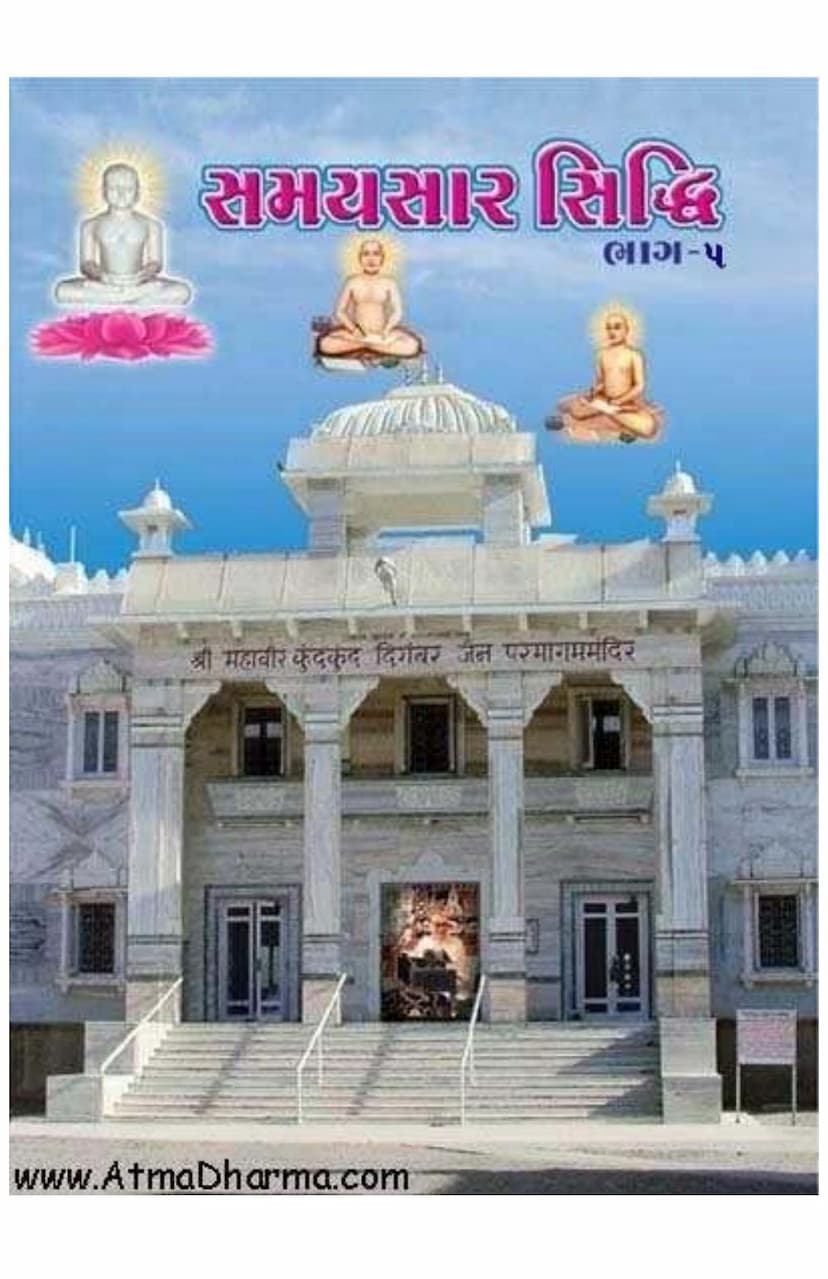Samaysara Siddhi 5
Added to library: September 2, 2025

Summary
This is a comprehensive summary of the Jain text "Samaysara Siddhi Part 5" by Kanjiswami, based on the provided pages:
Book Title: Samaysara Siddhi Part 5 Author: Kanjiswami Publisher: Shree Simandhar Kundkund Kahan Adhyatmik Trust, Rajkot
Overall Scope: This book, "Samaysara Siddhi Part 5," contains 42 sermons by the revered Acharya Kanjiswami on chapters 94 to 144 of the Samaysara scripture, specifically focusing on the "Karta-Karma Adhikar" (The subject of Doer and Deed). The sermons, delivered for the 19th time by Gurudev Kanjiswami, explore the profound spiritual concepts within these verses, elucidating the true nature of the soul (Atma) and its relationship with actions (Karma) and other substances (Dravya).
Key Themes and Concepts:
-
The True Nature of the Soul (Atma):
- The core message throughout the text is the inherent purity, divinity, and eternal nature of the soul (Atma). It is described as pure consciousness, an ocean of bliss, a mountain of joy, and an embodiment of knowledge and peace.
- The soul is fundamentally distinct from all other substances, including karma, body, mind, speech, and all external objects (dravya). It is the true self, existing independently of these external factors.
-
The Role of Ignorance (Agnan) and Knowledge (Gyan):
- Ignorance (Agnan): The primary cause of suffering and bondage is identified as ignorance (Agnan), which leads to the mistaken identification of the soul with non-soul substances. This ignorance manifests as false perception (mithya-darshan), false knowledge (mithya-gyan), and non-restraint (avirati).
- Consequences of Ignorance: Ignorance leads to the soul acting as the doer (karta) of actions and experiences (karma), resulting in the cycle of birth and death (samsara). The soul mistakenly identifies itself with states like anger (krodh), pride (maan), deceit (maya), greed (lobh), attachment (raag), aversion (dvesh), and even the physical body and its functions.
- Knowledge (Gyan): True knowledge (Gyan), specifically self-knowledge (Atma-gyan) and the discernment of soul from non-soul (bhed-gyan), is presented as the path to liberation. This knowledge helps in overcoming ignorance and realizing the soul's pure, liberated state.
-
The Illusion of Causation and Agency:
- Soul as Doer/Non-Doer: The text meticulously argues that the soul, in its true nature, is not the doer of external actions or the creator of its own states or the states of other substances. The Soul is intrinsically pure consciousness and bliss.
- Karma and Ignorance: External actions (karma) and their results are understood as arising from ignorance and the mistaken belief in agency. While the soul may experience the results of karma, it does not perform the actions that create or bind karma in its true essence.
- Nimittha (Instrumental Cause) vs. Upadana (Material Cause): The sermons highlight that while external factors (like karma, mind, body) may appear as causes, the true perspective is that the soul's own state of consciousness (ignorance or knowledge) is the primary factor in its experience of bondage or liberation. The soul's own disposition (pragmatic causality) is what leads to its experience, not an external agent.
- The Unchanging Nature of the Soul: Despite the soul's experience of changing states (like attachment, aversion, or even the illusion of acting), its fundamental essence remains pure, unchanging, and eternal.
-
Distinction between Soul (Jiva) and Non-Soul (Ajiva):
- A significant portion of the text is dedicated to distinguishing the soul (Jiva) from all non-soul (Ajiva) substances. This includes physical matter (pudgala), space (akash), time (kala), motion (dharma), rest (adharma), and even the subtle influences of karma and mind.
- Karma as Non-Soul: Karma itself is repeatedly emphasized as being material (pudgala) and therefore non-soul (ajiva). The soul's interaction with karma is explained through the lens of its own spiritual state (ignorance or knowledge) and its causal relationship, not direct agency. The Soul does not create or change karma; rather, its own state influences how it experiences the karmic results, or binds new karma through its own inclinations.
-
The Path of Liberation (Moksha):
- The ultimate goal is the realization of the soul's true, pure, and liberated nature. This is achieved through right faith (samyak-darshan), right knowledge (samyak-gyan), and right conduct (samyak-charitra), all rooted in self-awareness and the understanding of the soul's intrinsic qualities.
- The sermons emphasize the importance of constant contemplation of the soul's true nature and detachment from all external and internal impurities (vikars).
-
Critique of Ritualism and External Practices:
- While not explicitly detailed in the provided initial pages, the context of Kanjiswami's teachings often involves a subtle critique of relying solely on external rituals or meritorious deeds (like charity, fasting, worship) without the foundational understanding of the soul's true nature. These practices, if driven by attachment or ego, do not lead to liberation.
Kanjiswami's Approach: The introduction highlights Kanjiswami's pivotal role in reviving the understanding of Jain Agamas in the current era, which was perceived as shrouded in ignorance. His discourses are described as clear, accessible, and illuminating, bringing out the subtle and profound meanings embedded within the ancient texts, particularly Samaysara. His ability to explain complex spiritual concepts with clarity and connect them to the lived experience of the listeners is celebrated.
Structure and Content: The text is structured around Kanjiswami's discourses, following the sequence of the Samaysara scripture. The sermons, detailed with their corresponding verse numbers, dates, and page numbers, provide a clear roadmap of the content covered. The initial pages also include devotional verses (stutis) praising Lord Mahavir, Acharya Kundakunda, and the spiritual lineage leading to Gurudev Kanjiswami.
In essence, Samaysara Siddhi Part 5 is a profound spiritual discourse that aims to guide seekers towards self-realization by unveiling the true nature of the soul, the causes of bondage, and the path to liberation, all rooted in the profound teachings of Acharya Kundakunda.